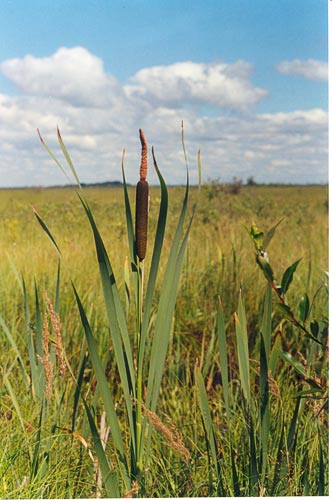Weeds
Typha latifolia L. - Broadleaf, Common Cattail.
Systematic position.
Family Typhaceae, genus Typha L.Biological group.
Perennial rhizome plant.Morphology and biology.
Rhizome is creeping, strongly ramified. It is covered with scaly leaves in two rows. Stalks are 100-250 cm tall, thick, cylindrical. Leaves are widely linear, up to 20 mm wide. Inflorescence is spadix, single, located at top of stalk. It consists of male stamina and female pistillate parts. Both parts adjoin, being sometimes separated by an interval of 1-3 mm. Male inflorescence cylindrical, with covering leaf at base; usually with 3 stamens; strings of stamen 2-3 times longer than anthers. Anthers reach up to 3 mm in length. Pistillate part of inflorescence black-brown; stigma usually lanceolate or rhombic, considerably exceeding length of hair-like perianth. Pistillate flowers without bract. Gynaecium is 3-4 mm, located on leg; the leg is 3-4 times longer than gynaecium. Plants are wind-pollinated; seeds are distributed by wind for significant distances. Upon maturing the seeds keep hairs.Distribution.
T. latifolia is a Holarctic polyzonal species. In the territory of the former USSR it is found in all areas of the European part and the Caucasus, in Western, Central and Eastern Siberia. In the Far East the species is found in Kamchakta and Ussuriisk areas, and on Sakhalin. The general distribution includes Scandinavia, northern areas of Mongolia and China, Japan, Northern America. Typha latifolia is a widespread plant. It grows on coasts of the rivers, river pools, lakes, on bogs, on places of dredging of peat, clay. It is found in water meadows, among bushes, mainly on sandy ground in fields, dry and weedy places, in steam fields, less often in crops, on deposits, it is common on roads and on boundaries, in winter and a spring wheat, in winter neigh, in oat. It is distributed almost everywhere, it is especially plentiful in the south of the European part (Keller et al., 1934) of the USSR. The species Typha latifolia has a disjunctive area. The basic zone of distribution is located in the European part of the USSR, Western and Central Siberia, and also in areas of the Caucasus. The northern European border of the area coincides with the border specified in the atlas of Hulten & Fries (1986). In Western and the Central Siberia, the northern and southern borders of the area generally coincide with the borders of the distribution of the arable lands map (Koroljeva et al., 2003). In the area of Eastern Siberia Typha latifolia was found in Central Yakutia according to the following sources: Tolmachev (1974), Krasnoborov (1997). The basic zone of distribution in the Far East part of the area was excluded. This is in conjunction with the data of Kharkevitch (1992) and Voroshilov (1982). In Central Asia the species is found sporadically in old channels, in crude and marshy places, on the coasts of lakes and rivers, in rice fields, from plains in the north up to the middle zone of the mountains. The weed causes harm to rice crops (Ulyanova, 1998). It litters irrigation systems of rice fields (Buch et al., 1981).Ecology.
It grows in boggy places, in river bottomlands, in old river channels, on water meadows, along coasts of lakes and water reservoirs. In Crimea it is usually found along roads and on boundaries, in winter and spring wheat, winter rye, oats. In rice-growing areas it grows quite often in rice fields, mainly at their margins, where it does not fructify often. Found in rows and along irrigation channels on rice plantations, in abandoned rice fields.Economic significance.
The weed causes harm to rice crops. It litters irrigation systems of rice fields. As a weed the species is more abundant in rice fields of the Far East, whereas the other species are weedy in other rice-growing areas. Measures of control include: initial ground drainage promoting eradication of many marsh species of plants, crop rotation with mesophytes (soya, potato, grain) differing by ecology from rice and weed species, careful cleaning of channels of irrigation systems.Reference citations:
Buch T.G., Kachura N.N., Shvydkaya V.D., Andreeva E.R. 1981. Weeds of the Primorskii Territory and their control. Vladivostok: Dalnevostochnoe knizhnoe izdatelstvo. 256 pp. (In Russian)Cherepanov S.K. 1995. Vascular plants of Russia and adjacent states (of the former USSR). Saint Petersburg: Mir i semya-95. 991 pp. (In Russian)
Keller B.A., Ljubimenko V.N., Maltsev A.I., Fedtshenko B.A., Shishkin B.K., Rodzevic R.Yu., Kamenski K.V., eds. 1934. Weed plants of the USSR. V. 1. Moscow-Leningrad: AN USSR. 324 pp. (In Russian)
Keller B.A., Lyubimenko V.N., Maltsev A.I., Fedtshenko B.A., Shishkin B.K., Rodzevic R.Yu., Kamenski K.V., eds. 1934. Weed plants of the USSR. V. 3. Moscow-Leningrad: AN USSR. 448 pp. (In Russian)
Kharkevich S.S., ed. 1992. Vascular plants of the Soviet Far East. V. 8. Saint Petersburg: Nauka. 384 pp. (In Russian)
Komarov, V.L. & M.M. Il'in, eds. 1934. Flora of the USSR. V. 1. Leningrad: AN SSSR. 302 pp. (In Russian)
Krasnoborov I.M., ed. 1984. Keys to plants of Tuva ASSR. Novosibirsk: Nauka. 336 pp. (In Russian)
Kuminov A.V., ed. 1973. Keys to plants of the Novosibirsk Region. Novosibirsk: Nauka. 368 pp. (In Russian)
Maevskii, P.F. 1954. Flora of middle belt of the European part of the USSR. Moscow-Leningrad: Selkhosgiz. 912 pp. (In Russian)
Malyshev, L.I. & G.A. Peshkova, eds. 1979. Flora of the Central Siberia. V. 1. Novosibirsk. 536 pp. (In Russian)
Nikitin V.V. 1983. Weed plants of the USSR flora. Leningrad: Nauka. 454 pp. (In Russian)
Popov M.G., Busik V.V. 1966. Abstract of flora of coasts of Lake Baikal. Moscow-Leningrad: Nauka. 336 pp. (In Russian)
Tolmachev, A.I., ed. 1974. Flora of North-East of the European part of the USSR. V. 1. Leningrad: Nauka. 276 pp. (In Russian)
Tolmachev A.I., ed. 1974. Keys to higher plants of Yakutia. Novosibirsk: Nauka. 544 pp. (In Russian)
Ulyanova T.N. 1998. Weed plants in flora of Russia and other FSU countries. Saint Petersburg: VIR. 233 pp. (In Russian)
Vasilchenko I.T., Pidotti O.A. 1975. Keys to weed plants of areas of irrigated agriculture. Leningrad: Kolos. 375 pp. (In Russian)


